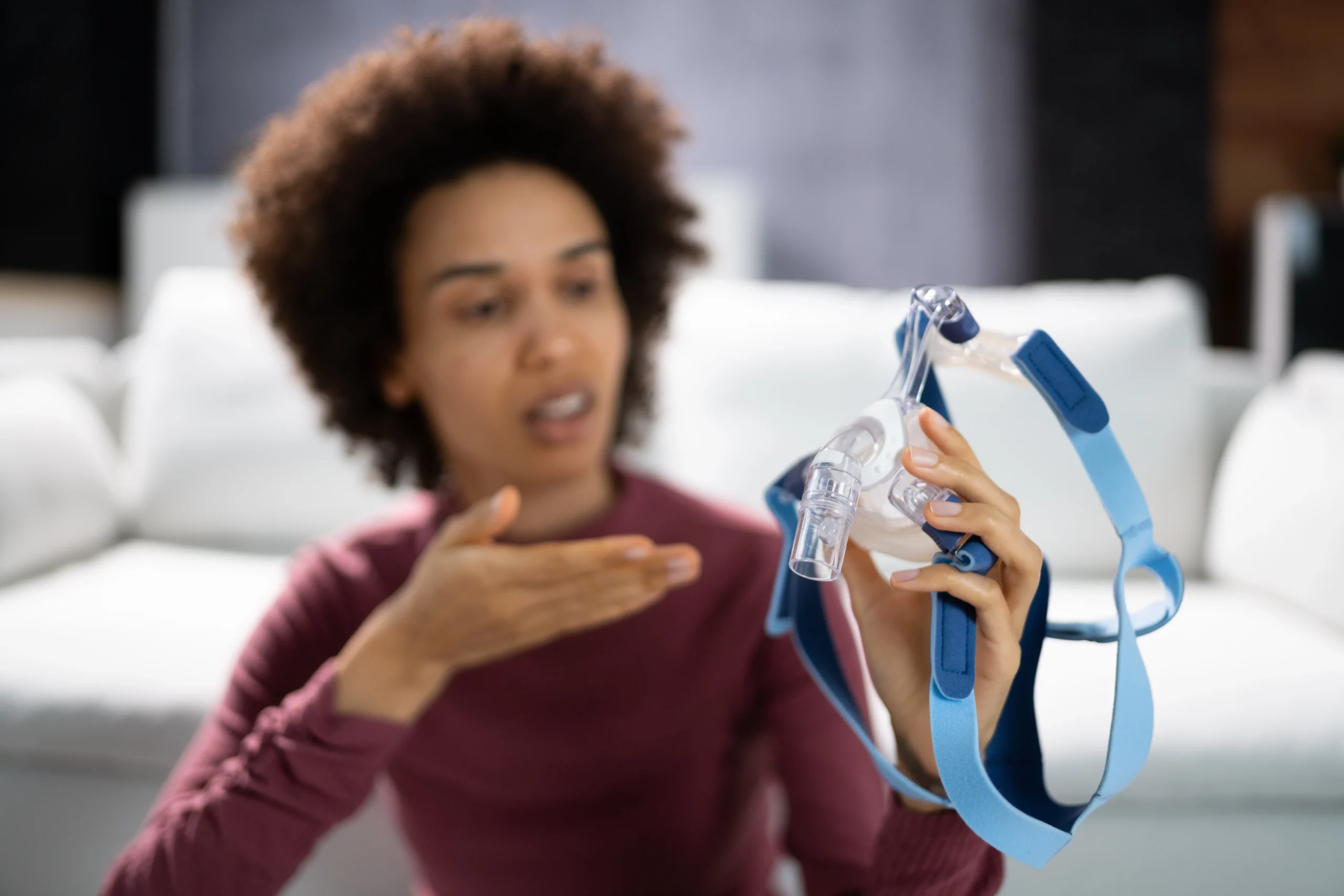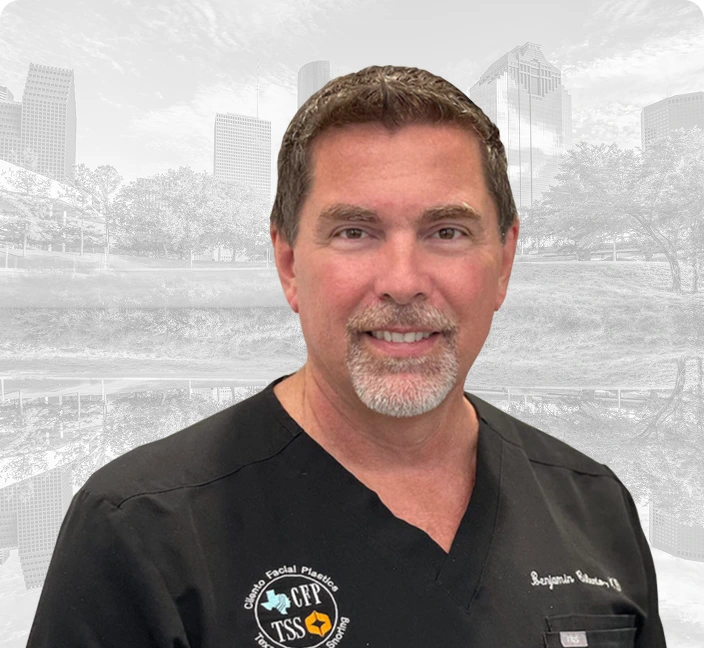Nasal Obstruction Is a Primary Cause of Suffocating Feelings
Nasal obstruction refers to the partial or complete blockage of the nasal airway, resulting in breathing difficulties. Individuals with nasal allergies, sinus problems, a deviated septum, or nasal polyps often suffer from moderate to severe nasal obstruction.
When a person wears a CPAP mask, it is essential to have unobstructed airflow through the nostrils to optimize treatment effectiveness and comfort. If the nasal airway is partially or entirely blocked, CPAP pressure may feel suffocating due to increased resistance or excessive pressure buildup.
Common Reasons for CPAP Therapy Failure
1. Mask Leakage
When nasal congestion or obstruction affects the secure fit of the CPAP mask, it can cause improper sealing and air leakage. This reduces the therapy’s effectiveness and leads to discomfort and a perceived sense of suffocation.
2. Ineffective Pressures
Nasal obstruction can limit the ingress of airflow from the CPAP machine, causing increased pressure requirements to maintain an adequate airway. These higher pressures may exacerbate discomfort and make breathing against the elevated resistance feel restrictive.
3. Difficulty Exhaling
Nasal congestion can make exhaling against positive airway pressure more challenging for some individuals. This sensation can contribute to feelings of suffocation, triggering additional discomfort and undermining the benefits of therapy.
4. Ineffective Treatment
Sometimes people with long-standing nasal obstruction are unaware that they are having difficulty breathing. The only indication that there is a problem is when they try CPAP and it fails to treat the sleep apnea adequately. Sleep partners can often hear patients snoring through the mask. Individuals with nasal obstruction may wake up feeling tired despite wearing the mask all night.
How Can We Treat Nasal Obstruction and Improve the CPAP Experience
Nasal Saline Sprays or Rinses
Using nasal saline sprays or rinses can help clear mucus and reduce inflammation, making it easier to breathe through your nose and fall asleep with less difficulty. These gentle solutions help keep the nasal passages moist and free of irritants, which can significantly improve comfort during CPAP therapy.
Nasal Corticosteroid Sprays
Nasal corticosteroid sprays reduce swelling inside the nasal passages, which can relieve congestion and the suffocating feeling that many patients experience with CPAP. By decreasing inflammation, these sprays help create a clearer airway, making pressurized air from the CPAP machine easier to tolerate.
Oral or Nasal Antihistamines
Oral or nasal antihistamines are effective for managing allergy-related nasal obstruction by reducing histamine reactions that cause swelling and congestion. These medications can improve nasal airflow, helping CPAP users breathe more easily throughout the night.
Decongestants
Decongestants help open nasal airways, reducing the need for mouth breathing during CPAP use. By keeping the airways open, decongestants allow the machine’s air pressure to flow more smoothly, improving comfort and therapy effectiveness. However, they should be used cautiously and for short periods to avoid rebound congestion.
Allergy Treatments
Allergy treatments, including immunotherapy and avoidance strategies, target the root causes of nasal inflammation and congestion. By controlling allergic reactions, these treatments promote restful sleep and enhance CPAP tolerance by maintaining clearer nasal passages.
Humidification With a CPAP Machine
Humidification is essential for many CPAP users to adjust pressure settings comfortably. By controlling the humidity level, humidifiers prevent rainout (condensation inside the mask) and add moisture to the air, reducing dryness and irritation in the nasal passages during therapy.
Septoplasty
For patients with a deviated septum, septoplasty often provides the best solution to nasal obstruction interfering with CPAP therapy. This surgery can improve comfort with nasal pillow masks and overall CPAP effectiveness by correcting structural blockages.
Turbinate Reduction
Turbinate reduction surgery reduces the size of enlarged turbinates inside the nose, which can obstruct airflow. This procedure can make a big difference in improving nasal breathing, allowing CPAP users to tolerate therapy for longer periods without discomfort.
Polypectomy
Polypectomy involves removing nasal polyps that block airflow, leading to significant improvements for CPAP users. Clearing these obstructions can make a big difference in therapy comfort and adherence, enabling patients to use their CPAP machines longer.
Endoscopic Sinus Surgery
Endoscopic sinus surgery is a minimally invasive procedure specifically designed to open blocked sinus pathways and improve oxygen flow. By restoring normal nasal function, this surgery can enhance CPAP tolerance and overall breathing during sleep.
Why Does a Full-Face Mask Make Patients Feel Claustrophobic?
Many patients feel claustrophobic when using a full-face mask because it covers both the nose and mouth, creating a sense of enclosure that can be overwhelming. The headgear and chin strap needed to secure the mask add to this sensation by restricting movement and adding bulk around the face. Despite having exhalation ports, larger masks sometimes create a feeling of carbon dioxide buildup inside the mask, which some users find uncomfortable or suffocating. In contrast, alternatives like nasal pillows or a nasal mask fit only over the nose, allowing for a lighter, less intrusive experience with pressurized air, which can help reduce feelings of claustrophobia.
How Can Nasal Pillows Help?
Adjusting the Parameters of Your Continuous Positive Airway Pressure (CPAP) Machine
Pressure Settings
Adjusting the pressure settings on your CPAP machine can significantly improve comfort and therapy effectiveness. It is important to make any changes only under professional medical advice, as incorrect pressure levels can reduce the treatment’s effectiveness or even worsen symptoms. Some users find the pressure sensation too intense, especially at the beginning of the night, which can make falling asleep difficult. By working with a sleep specialist to fine-tune your therapy settings, you can achieve an optimal balance that maintains airway support while minimizing discomfort, helping you stay consistent with CPAP use.
The "Ramp" Feature
The “Ramp” feature on most CPAP machines gradually increases air pressure over a set period, allowing you to fall asleep at a lower, more comfortable pressure before reaching the prescribed therapeutic level. This gentle adjustment can reduce the initial shock of pressurized air, making it easier to relax and breathe naturally. Many patients find that using the ramp setting improves sleep onset and overall tolerance, particularly if they have difficulty adapting to the sensation of continuous pressure immediately after putting on the mask.
Exhalation Relief (EPR/C-Flex)
Exhalation relief features, such as EPR or C-Flex, make breathing out against the CPAP pressure easier by slightly reducing airflow during exhalation. This adjustment can decrease feelings of suffocation or resistance for patients, especially those who struggle to exhale against the continuous air pressure. By providing a more natural breathing experience, these features enhance comfort and promote longer, more consistent use of CPAP therapy, helping patients maintain effective treatment throughout the night.
CPAP Mask Discomfort
Do I Need to Undergo a Sleep Study to Confirm Sleep Apnea?
Conclusion
Many factors can contribute to a CPAP feeling uncomfortable or even trigger feelings of suffocation. Structural issues, such as a deviated septum or other nasal obstructions, can restrict airflow, causing inadequate airflow that may feel overwhelming initially and, in some cases, even provoke a panic attack. During the initial adjustment, users may struggle with continuous airflow, selecting the right mask, and finding a fit that accommodates their unique face shape. Over time, however, most patients find relief as their bodies adapt during the adjustment period, which reduces the suffocating sensation and improves overall comfort with the therapy.
If you find that your CPAP feels suffocating, it is essential to consult with an ENT specialist (ear, nose, and throat specialist). Our professionals can perform a thorough evaluation, including assessing nasal patency, and develop a targeted treatment plan tailored to your specific needs. By addressing nasal obstruction, you can optimize the benefits of CPAP therapy and experience more comfortable and effective sleep apnea management.




